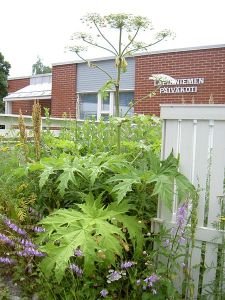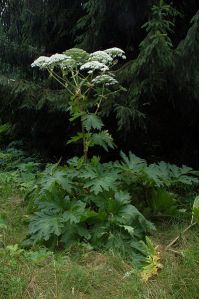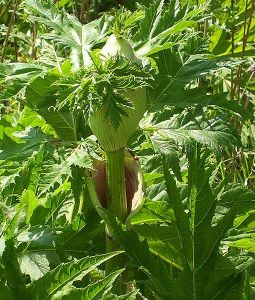The Federal Noxious Weed list includes Giant Hogweed. It self-seeds extremely quickly via wind and water and can quickly overtake native populations. Although similar in appearance to Cow parsnip, another species in this genus native to Washington in North America, this vile plant is native to southwest Asia. It has escaped cultivation and, without successfully alerting the public about the plant, can become an extremely serious problem. Being monoecious, it is also capable of self-pollination, unfortunately. Notable population sizes are appearing in Michigan. The United States federal government specifically lists Giant Hogweed as a critical problem in Alabama, California, Conneticut, Florida, Massachusetts, Minnesota, New Hampshire, North Carolina, Oregon, Pennsylvania, South Carolina, Vermont, and Washington. Southern Ontario and Quebec, as well as Cape Breton, New Brunswick, and eastern Newfoundland also report Giant Hogweed’s presence.
Heracleum mantegazzianum (Giant Hogweed, Cartwheel Flower)
Deciduous: yes
Hardiness Zones: 3-9
Height: 2.5-4.5 meters (10-15 feet) tall
Diameter: roughly 1 meter (3-4 feet) across
Growth Rate: slow (moreso in Canada), leaf growth typically occurs in spring
Age: Supposedly up to 15 years in extreme cases, typically a biennial.
Root System: A deep taproot extends 60 centimeters (24 inches) into the soil and is 15 centimeters (6 inches) wide at the crown.
Family: Apiaceae
Subspecies: none
Tolerates: most fires, due to its extensive taproot and crown
Problems (major): Very, very toxic – see “Poisonous:” below
Problems (minor): very few, Giant Hogweeds are considered “weeds”
Poisonous: EXTREMELY – the sap, which appears on the leaves and pretty much everywhere else on the plant, is highly toxic, can cause dermatitis, painful blisters and sores, long-term rashes, scarring, burns, and potentially blindness. If the sap is on your skin and comes into ultraviolet light (from the sun), which it will, immediately contact the authorities and your doctor or physician. Keep exposed areas in the dark as much as possible, and wash with COLD water.
Soil requirements: moist, fertile, well-drained soils with a neutral to acidic (5.6) pH promote growth
Air Requirements: moderately tolerant of pollution
Watering requirement: medium/moderate
Sun requirement: full sun (optimal growth) to part-shade, survives in almost full shade
Leaf shape: tenate-compound, deeply cut, basal leaves
Leaf size: up to 1 meter (3 feet) long
Flower structure: Produces an “umbel” (a large inflorescence spreading out from a center) anywhere from 3-4.5 meters (10-15 feet) tall in the second (potentially third) year of development. This inflorescence can produce as many as 20,000 seeds (one was recorded to set roughly 52,800 seeds). Even though the mother plant dies off (this type of plant is known as “monocarpic” for this reason – some offshoots/offsets may survive, however), thousands of new plants may germinate anywhere from 1 year to 20 years after dispersal. The flowers are white, and pollinated by a variety of insects.
Flowering frequency: blooms in June and July, lasts anywhere from 36 to 60 days, disperses seeds in August (dispersed either by wind or water, potentially birds or cattle), stratification necessary for seed germination
Bulb/tuber: neither, uses as a crown as its center of root development
Monocot/Dicot: dicot
Annual/Biennial/Perennial: biennial (some perennials are believed to be 25 years old)
Notable characteristics:
The sap Giant Hogweed produces, when in contact with ultraviolet light from the sun, leads to VERY SERIOUS problems. The reaction between the sap and sunlight is called “phytophotodermatitis”, and it causes extremely painful blisters, rashes, and potentially blindness.
Uses:
Don’t grow this. Cattle and pigs eat this, without any apparent symptoms, but they are still extremely harmful to humans. Some middle-eastern cultures use the seeds as a spice.
Sources used:
- http://www.missouribotanicalgarden.org/PlantFinder/PlantFinderDetails.aspx?kempercode=d265
- https://plants.usda.gov/core/profile?symbol=HEMA17
- Gucker, Corey L. 2009. Heracleum mantegazzianum. In: Fire Effects Information System, [Online]. U.S. Department of Agriculture, Forest Service, Rocky Mountain Research Station, Fire Sciences Laboratory (Producer). Available: http://www.fs.fed.us/database/feis/ [2014, April 19].
- http://www.fs.fed.us/database/feis/plants/forb/herman/all.html
- http://folk.uio.no/stephanf/baerklau/aqua012.html
- http://www.dec.ny.gov/animals/72934.html
- http://www.cipwg.uconn.edu/pdfs/USDA_Giant_Hogweed_Poster.pdf
- http://ohioline.osu.edu/anr-fact/hogweed.html
A mature plant, roughly 2.5 meters (8 feet) tall in Tampere, Finland (this photograph’s rights belong to Teemu Mäki)
A mature plant with a prepared umbel (uploaded 7 July 2007 by Fritz Geller-Grimm)
A close-up of the enormous inflorescence
Several seeds of H. mantegazzianum (uploaded 31 July 2007)
A close-up of the foliage, stem, and petioles (uploaded 13 June 2005)
Two emerging plants in April in Witten, Germany (uploaded 5 April 2006 by Spantax)
I do not own the rights of these images; all credit goes to its original creator(s).






